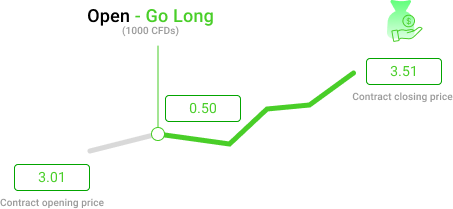

- MetaTrader 4
- MetaTrader 5
- WebTrader
- MobileTrader
-
CFDs vs Stocks

The main difference between trading CFDs on stocks and stocks trading is that when you trade a CFD you are speculating on an asset’s price without taking ownership of the underlying asset, and when you trade stocks you need to own the underlying stocks.
Another difference is that you can use leverage when trading CFDs. This will increase any profits, but also means that losses can exceed the invested sum. On the other hand, when you trade stocks, you will need to pay the full value of your position in advance.
-
Is high-frequency trading available on CFDs?

Yes. High-frequency trading is a trading method in which you use an algorithm that places orders to buy and sell assets. This method is applicable to any instrument - whether it's CFDs, stocks or futures. A broker or dealer must have an API to connect your trading robot.
-
What other fees are charged on CFDs trading?

Traders pay the spread
Spread is the difference between Bid and Ask price of a currency pair on Forex. Spreads can be variable (floating) or fixed. The floating spread varies depending on many factors, including asset liquidity and asset price volatility. The fixed spread remains the same regardless of the speed of the trend or the supply and demand of the currency. There is also trading without spreads, and fixed commissions are charged. All conditions depend on the type of account. A swap, also known as a rollover rate, is a fee for carrying over an open position to the next day. Swap free accounts are available with InstaForex. They are intended for traders who use trading systems that do not take into account the effect of swaps, or those clients who cannot use swaps due to their religious beliefs.
-
What is the leverage when trading CFD?

Leverage for CFDs varies depending on the underlying assets. For example, the leverage for CFDs on Forex is up to 1:30 while the leverage for CFDs on indices is up to 1:20.
-
How can I calculate the value of a pip when trading CFD?

The value of a pip for stocks is calculated on the basis of a trade volume.
Therefore, the value of a pip in a trade of 1 lot will be equal to $1; in a trade of 10 lot 1 pip will be equal to $10, etc.
Alternatively, according to this formula:
v. p. = volume * leverage * minimum price change
-
How much money is needed to open a deal?

For calculation of margin for stocks it is necessary to know the trade volume and the value of stocks.
For instance, the volume of a trade is 5 lots, the value of a stock is 47 USD.
You should keep in mind that 1 lot = 100 stocks. Also the leverage for stocks is standard 1:10.
Formula:
Multiply the value of a share by the number of stocks (trade volume) and divide by 10 (leverage 1:10)
47 USD * 500 stocks (5 lots)/10 = 2,350 USD
-
Where can I find information about CFD contract specification?

A detailed description of the terms of trade for one or another CFD contract is given in the specification table.

 Stay
Stay 



















